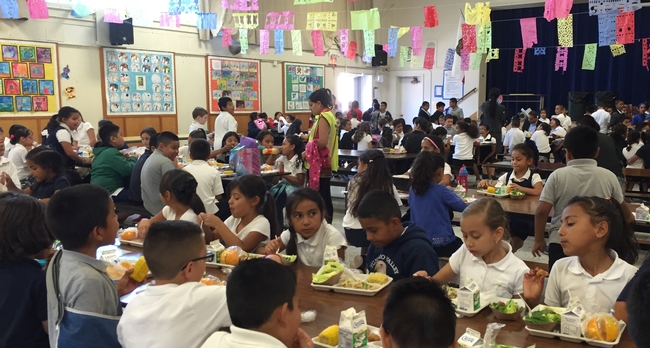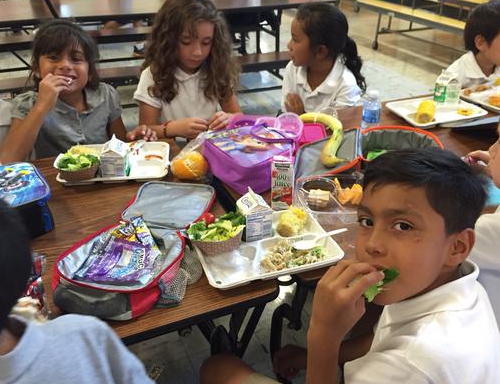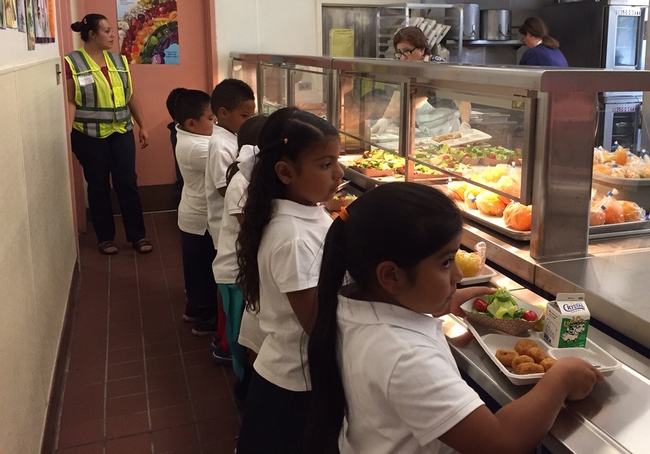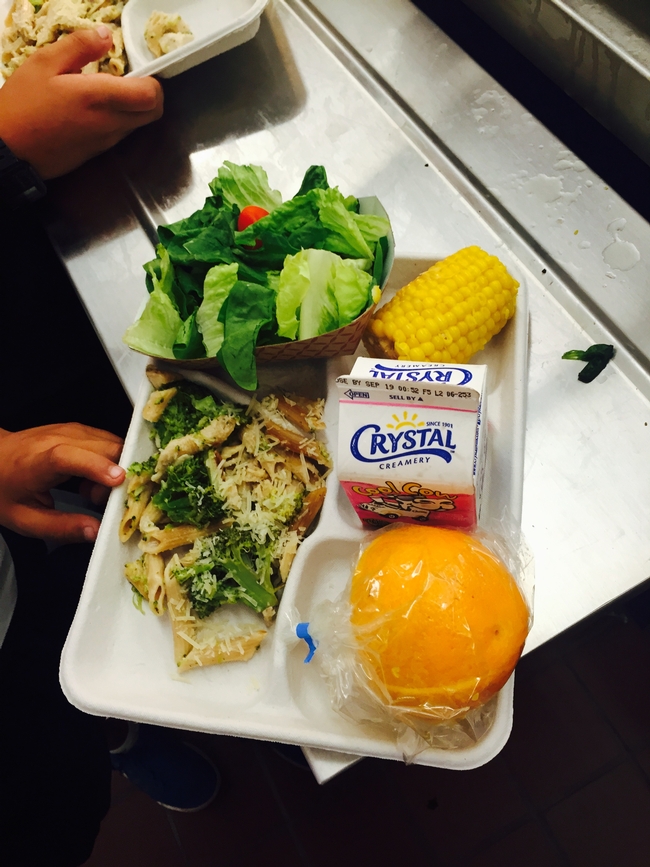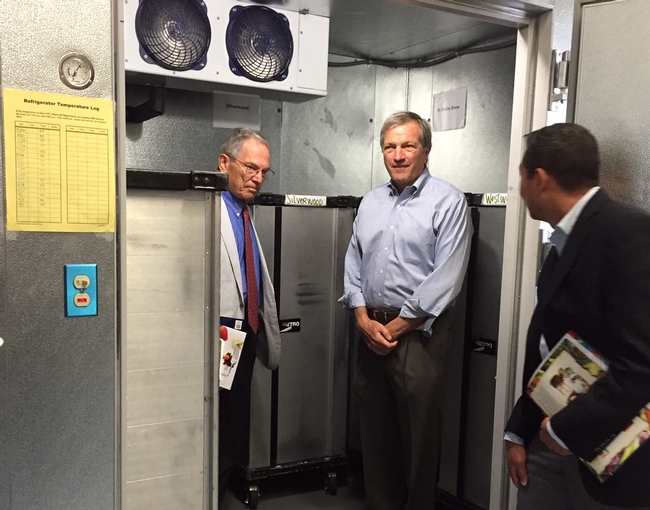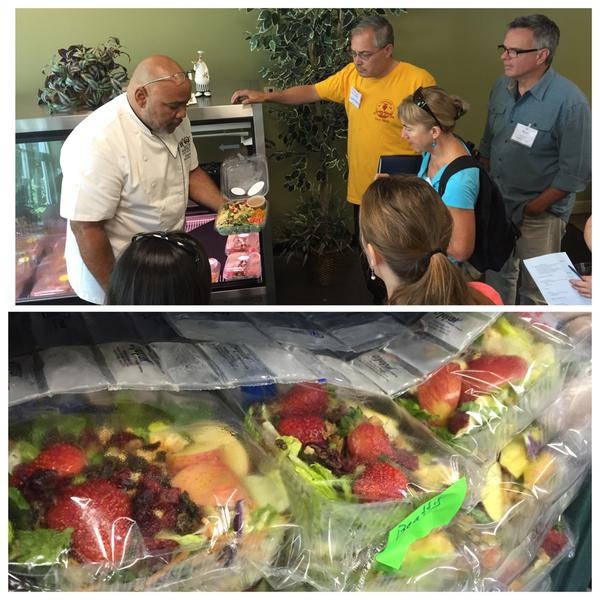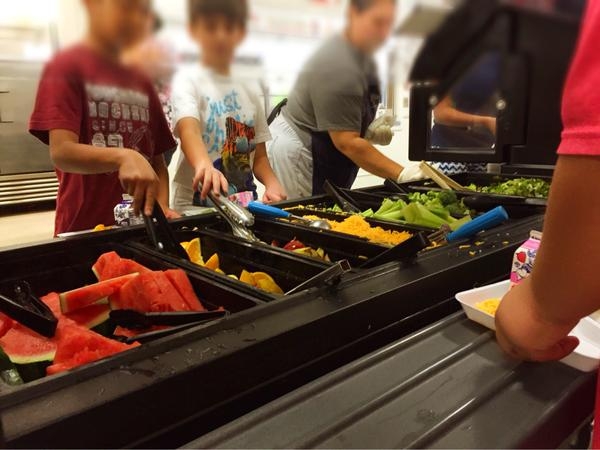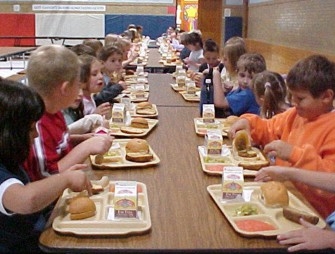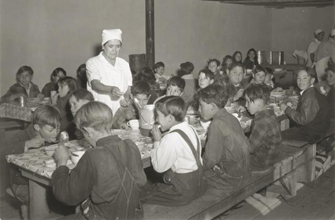Posts Tagged: childhood nutrition
Farm to fingers: Schools provide fresh fruits and vegetables for children’s meals
Several grade school students set down their forks to eat their green salad, picking up individual lettuce leaves with their fingers and pushing them into their mouths. Not that I was there to judge for style, it was just an observation as I looked around the cafeteria festooned in colorful hand-cut paper banners to see how many of the kids had taken a salad.
The youngsters are required to take at least a half-cup serving of fresh fruits or vegetables as part of a healthful meal to meet national nutrition standards, but I noticed they were voluntarily eating the fresh leafy greens and orange slices.
The children had selected the food themselves from a new serving line, which was made possible by a grant from the USDA aimed at encouraging children to eat healthier school lunches. U.S. Department of Agriculture has been providing a new round of grants since 2013 to upgrade kitchen and cafeteria equipment. Ygnacio Valley Elementary School is in Mount Diablo Unified School District, which received a USDA grant.
About one-third of children in California are overweight or obese, which is associated with serious health risks.
According to The Pew Charitable Trusts, 93 percent of school districts in California, and 88 percent nationwide, need at least one piece of equipment to better serve students nutritious foods.
Kenneth Hecht, director of policy for the Nutrition Policy Institute organized the Sept. 3 visit to the Mount Diablo Unified School District for Congressman Mark DeSaulnier and USDA executives to see the improvements.
The school district serves about 20,000 meals each day, nearly half of which (46.2 percent) are free or reduced price for children from low-income families. By replacing a refrigerator bought in 1973 with a new walk-in refrigerator, the central kitchen is able to store and serve twice as much fresh produce while saving energy and energy costs, said Anna Fisher, director of Food and Nutrition Services for Mount Diablo Unified.
The new serving line allows for food to be displayed so the children can select their own food, whereas before, each tray was filled by a server and handed to the students.
“We've seen that when the children select their own food, less food gets thrown away,” said Fisher.
“The examples we are seeing at Mount Diablo Unified School District are perfect illustrations of what these USDA grants can do, from the procurement of food to serving healthy meals to children,” said Hecht.
Congressman DeSaulnier, who ate lunch with the students, is sponsoring the School Food Modernization Act (HR 3316) to continue and strengthen the USDA grants program.
Another piece of federal legislation aimed at improving child nutrition is the Healthy, Hunger-Free Kids Act of 2010, which includes farm to school support and expires on Sept. 30, 2015.
“This fall is a pivotal time for the future of Farm to School programs across the country,” said Gail Feenstra, deputy director of the UC Sustainable Agriculture Research and Education Program (SAREP) in the UC Division of Agriculture and Natural Resources.
On Sept. 2, SAREP and the Urban Environmental Policy Institute at Occidental College hosted a tour of farm-to-school sites in the Riverside Unified School District where Los Angeles-area participants were able to meet with farmers, school chefs, food service directors, advocates, researchers and elementary students and to witness firsthand the benefits and challenges of providing farm-fresh fruits and vegetables to Southern California schoolchildren.
Riverside schools have transitioned from heating prepackaged meals to buying local produce and preparing fresh food on-site.
According to Kirsten Roloson, director of Nutrition Services, and Adleit Asi, operations manager, Riverside Unified now buys $400,000 worth of produce from local farmers. One farmer, Bob Knight, who supplies oranges and other produce to Riverside Unified, said he's making five to seven times more money selling to schools than he did before.
“Farm-to-school programs increase access to fresh, healthy produce among school children while also supporting local farms,” said Feenstra. In California, she noted that 2,626 schools participate in farm-to-school programs, serving 1.8 million students and buying more than $51 million in produce from local California farmers.
Feenstra will be leading a similar farm-to-school tour for policymakers in Sacramento on Sept. 29.
"With new equipment and fresh produce, schools can prepare healthy and more appealing school meals that may be the most nutritious meal a child receives that day," Hecht said.
Whether children eat with forks or fingers, the nutritional quality of the food they eat can affect their lives, long term.
The University of California Global Food Initiative aims to put the world on a path to sustainably and nutritiously feed itself. By building on existing efforts and creating new collaborations among UC's 10 campuses, affiliated national laboratories and the Division of Agriculture and Natural Resources, the initiative will develop and export solutions for food security, health and sustainability throughout California, the United States and the world.
Healthalicous cooking
Our youth deserve a future filled with promise and possibilities. A strong body and good health is the foundation on which a successful future can be built.
UC ANR’s new after-school curriculum is designed to help 9- to 12-year-olds develop good health skills that will last a lifetime. The six-week hands-on program promotes preparing and eating healthy meals as well as encouraging plenty of physical activity. Healthy eating and physical activity work together to help reduce obesity levels.
These free, downloadable lessons include:
- Let’s Make It Clean: Wash Up!
- Make It Healthy: Eat Balanced Meals
- Make It Crunchy: Go for Whole Grains!
- Make It Colorful: Choose Fruits and Veggies by Color
- Make it Delicious: Plan and Balance
- Make It Fun: Eat and Share
Lunch ladies deserve the nation's support
The lunch lady at Cabrillo Middle School in Ventura, Calif., delivered the best commencement speech I’ve ever heard. In mid-June, Rita Pisani, whose passion is nourishing the bodies and spirits of people by preparing and serving them good food, spoke to more than 800 eighth-grade graduates and the well over 1,000 people who came to cheer them on.
Having a lunch lady be the featured speaker at an eighth-grade promotion might raise the eyebrows of some, but for this school and this school district, it makes sense. Cabrillo is part of the Ventura Unified School District, which operates farm-to-school salad bar programs at 17 campuses, and has gained national attention as an early adopter of farm-to-school and innovative nutrition programs. The farm-to-school program is part of the larger Healthy Schools Program, which also provides nutrition education and support for school gardens.
The choice of Rita Pisani as the person to deliver the parting words of wisdom to teens embarking on their high school journey also made a lot of sense in terms of a national context. With a White House supporting good food, gardening and obesity prevention initiatives, with the USDA sponsoring its People’s Garden Initiative, with farm-to-school and other good food advocates challenging the status quo with the school lunch program, it makes sense that someone like Mrs. Pisani – who has dedicated her life to feeding people, especially kids – should be heard. Food, after all – especially good food – is central to the health and well being of our youth and central to our success and security as a nation in the future.
Mrs. Pisani told a compelling story about a young girl. Born in wartime Italy, this girl’s hearing was severely damaged by bombing raids that occurred when she was very young. (The girl’s hearing loss was not fully diagnosed until she was 25; it was determined to be 80 percent in both ears, and she had surgery and was given hearing aids). Knowing that being “different” might result in limited opportunities for her daughter, the girl’s mother taught her how to read lips, analyze facial and eye expressions, and study gestures. As an eighth-grader the girl immigrated to the United States and was immersed in English-only classes, even though she spoke only Italian. A dedicated teacher spent two hours a day helping the girl learn English. The surprise ending? That girl was Rita Pisani, the lunch lady.
Mrs. Pisani shared her belief that this is exactly the time in life when these young people will have to make decisions, particularly about the kind of people they will be. And they are of an age where they will have to live with their choices. (And one choice she strongly encouraged them to make? Don’t cut in line!).
Some of the most important choices will center on how these teens choose to care for and nourish their bodies. As citizens and taxpayers, it’s in our best interest to make sure that good food choices in public schools are the norm, not the exception.
Lawmakers are taking action on the issue of childhood nutrition. Before its August recess, the Senate passed S3307 (the Healthy, Hunger-Free Kids Act), which would invest $4.5 billion into child nutrition. The clincher? It offset the proposed increase to childhood nutrition programs by suggesting a $2.2 billion reduction in the SNAP (formerly Food Stamps) program, where need is growing due to the nation’s dire economic situation. Over the summer, the House Education and Labor Committee passed HR 5504 (Improving Nutrition for America’s Children Act), which would invest $8 billion in childhood nutrition; however, the bill is stalled, because funds to pay for this have not been located.
The Childhood Nutrition Reauthorization Act, a major omnibus bill, includes numerous components, and is also stalled in Congress. It is renewed on a five-year cycle; Congress should have renewed it in 2009, but the national dialog about health care delayed discussion and passage. The bill has been extended until Sept. 30, 2010. It encompasses the National School Lunch Program; the School Breakfast Program; the Child and Adult Care Food Program; the Summer Food Service Program; Women, Infants and Children (WIC), including, the WIC Farmers’ Market Nutrition Program; the Fresh Fruit and Vegetable Program; and the Special Milk Program. Because the Act is so large and comprehensive, it’s important for citizens to learn more about it and its components. Information is available at www.schoolnutrition.org/Content.aspx?id=2402
All of the legislation described above affects children and lunch ladies across the nation, lunch ladies like Mrs. Pisani. I have considered Mrs. Pisani’s words over and over the last few months. As she concluded her remarks, she told Cabrillo students, “I love to cook for people and serve them food. This is my passion. I have done it as a head chef, restaurant owner and caterer most of my life. This is why now I am happy to be your lunch lady.” Cabrillo’s principal, Glory Page, made an important observation about Mrs. Pisani: “She serves food, but more importantly, she serves kids.”
Lunch ladies do serve kids, in all sorts of ways. I loved my lunch lady, Mrs. Ketchell, who helped us work through challenges and life problems by engaging us to work alongside her in the cafeteria at Joshua Elementary School. The privilege of working in the cafeteria was reserved for older students. We couldn’t wait for our week to help prepare and serve food, and clean the cafeteria after lunch. It connected us to caring adults, it instilled in us a work ethic, it honored the collaborative and community nature of food preparation and eating, it enabled us to serve other students and it connected us to our food.
Times have changed, but the hearts of lunch ladies haven’t. It’s up to us to make it possible for them to even more effectively serve kids by giving them the money they need to serve those kids good food. The choice of commencement speaker couldn’t have been better or more relevant to this national moment. Thank you, Mrs. Pisani, for great lunches and great lessons.


